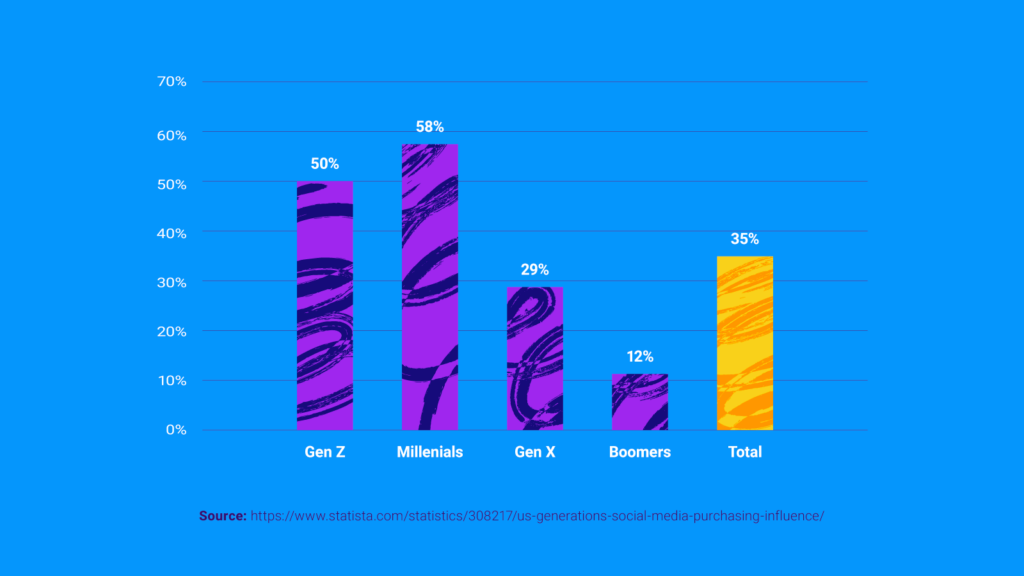When you open up your phone with no notification, text message, or email, what is the first thing you do? If you’re like me, you probably open up social media to gauge what’s happening. Social media is an integral part of many people’s lives, and your business’s social media advertising should reflect this.
Social media advertising is an element of an online business that seems daunting at first but can be one of the most lucrative aspects of your company. If you’re a start-up wishing to get your name out there, this will be your most challenging task.
I know from experience that social media platforms can be the primary solution to your brand’s online presence. Unfortunately, raising brand awareness is easier said than done. Here’s what you need to know to master social media advertising.
Social Media Advertising Explained: How Does It Work?
Social media advertising is one of the simplest yet, ironically, most complex forms of digital advertising out there. The basics are enough for anyone to understand: It involves ads you buy or sell to promote on social media platforms like Twitter and Facebook. These paid advertisements are delivered right to consumers.
Some of the ad companies you can work with will give you the option to deliver based on demographic, location, age, and all that good stuff. The ads can come in various formats, including videos, images, and featured posts. Social media advertising aims to get your name out there and increase sales in the process.
Why your online company needs social media advertising
Every online company needs social media advertising of some kind. Even some content creators who might not be running an Etsy or online storefront should consider it. Your name and brand are your business, and garnering more attention towards it means further success over time.

Given that social media platforms are arguably the number one place for people to hang out online, you must carve out a slice of that for your company. In today’s age, Statista notes that 75% of Gen Z buy items because of social media, while 48% of millennials find recommendations through these platforms.
These are your target audiences, and they are influenced by what they see online. If you aren’t taking full advantage of that, you aren’t likely to be as successful as you could be. In addition, newer companies have no online presence or notoriety whatsoever. Unfortunately, social media advertising is necessary to get that started because consumers won’t come to you automatically.
Social Media Ad Platforms You Should Be On
I’ll be the first to admit that the prospect of social media advertising is a daunting and overwhelming task. I know this from experience (more on that in a bit), but I hope to simplify this matter for you.
First, it begins with your social media advertising platform (and related social media advertising software).
Here are the social media platforms you should consider for ad campaigns and some insight I have for using each of them.
Facebook is more personal than other social media platforms. It’s where people generally connect with close friends and family rather than strangers. This aspect makes Facebook a solid foundation for paid social media ads. As people mindlessly scroll through the same old pictures of dogs and parties, an ad can be an intriguing respite.
The uniqueness of some Facebook ads, usually in the form of videos or slideshows of images, can garner quick attention. Facebook advertising also offers integrated features like buttons that lead to store pages and the like for quick purchases. I know that I have made some buying decisions, such as Olipop, because I discovered it on Facebook when the company was still in its early days.
With a generally more open platform for connectivity on Twitter than other social networks, it can be lucrative to spend money on brand advertising here. Some of the unique features of this platform include promoted tweets and the ability to dominate trending topics if you can get into the conversation using the right Twitter ads.
Like Facebook, Twitter users are prone to endlessly scroll until oblivion, allowing you to occasionally interject with eye-catching posts of images and videos that show off your product or service.
Instagram is a visually-focused social media app, and it should be treated as such when advertising here. Colorful images, Instagram Stories, and the occasional trendy video will do best here. Instagram advertising is a challenge on a platform that is solely based on people sharing their latest selfies and quick video clips from their phones.
TikTok
TikTok is the pinnacle of short-form media today, with almost nothing but relatively quick meme videos and dance clips. Trends are the name of the game here, and they require a unique sense of understanding of today’s ever-changing culture. It is possible to thrive as a business on TikTok, but it involves jumping on early trends (such as new sounds and songs) to fully succeed.
YouTube
On the other end of the video equation are the longer-form videos on YouTube. It is one of the broadest platforms out there for video advertising since there are so many options, from in-stream videos to banners on the side to even sponsored videos using some of the biggest content creators around.
Snapchat
Snapchat is still going strong, even if its use for advertisers is minimal. Many businesses forget about this platform, which opens the doorway for products and companies to advertise visually here. But to succeed on this platform, you must truly offer something unique and immediately appealing to the eyes. Otherwise, it will be ignored without thought.
Pinterest is another social media site for the eyes. While sharing cooking recipes and home decor ideas is at its core, Pinterest can be a lucrative platform for the right online businesses. If you sell a product that is related to the relaxing and beautiful aesthetics that thrive on Pinterest, such as cookware or furniture, you should consider this location.
For those like me who are content creators, consultants, and/or SaaS aficionados, LinkedIn advertising is a quieter but brilliant platform for potential customers. This is a social media platform for professionals, offering unique forms of communication through its sometimes trending posts and open-ended messaging system.
While it can be hit-or-miss, there is something to be said about using LinkedIn ads to target people who have certain keywords or career histories with your services. I receive promotions here almost daily with regard to the places I’ve written for in the past, and it almost always guarantees at least a look, even if I’m not interested in the end.
Types Of Social Media Ads To Consider For Your Online Business
Beyond deciding what social media sites to promote yourself on, there is also the way that you advertise your company that is worth considering. Videos work best on some social platforms, but simple texts and links might be the most optimal solution for others.
Here are the general ad formats you’ll find on most social media platforms.
1. Static ads
The first type of ad for social media is one of the simplest: a static image that you scroll by. In general, it could be a picture of your product with a string of text or a caption accompanying it. In general, these types of ads work best on spots like Facebook, Instagram, and Snapchat, where pictures are welcome.
2. Out-stream video ads
Digital video advertising is becoming more and more crucial online, but there are a couple of different versions you should know about. Out-stream video ads are found on sites outside of the videos someone is trying to watch online. For instance, on Facebook, this could be a marked sponsored video that someone finds interjected between their families’ posts.
On another platform like TikTok, it could be an ad that pops up after scrolling through a dozen TikToks of the same current dance trend. But then it could also mean a video on the side of the screen like on YouTube. It may not interfere with the actual YouTube video you’re trying to watch, but it is always there on the side looping and vying for the viewer’s attention.
3. In-stream video ads
In-stream video ads are the most in-your-face type of social media ad you’ll find. This is on platforms where video is the most important part, such as Facebook Reels or YouTube videos. Before or during a video you’re trying to watch, these ads will interrupt and inform the viewer about their company.
These video ads are sometimes skippable, while other times forcing the person to sit through a 15-second or 30-second clip about their product. While a bit more forceful than other advertisement types, there’s no denying they nail the idea of getting the viewer’s attention.
4. Slideshow ads
Similar to static image ads, slideshow ads excel on places like Facebook and Instagram. Instead of a single image, they might show a slideshow carousel of images for you to browse through from left to right. These are more specific to companies with destinations or restaurants to show off, but they can be intriguing.
So long as the first image in the slideshow is eye-catching enough with a gorgeous location, someone might scroll through them with curiosity or simply be unaware that it is an ad at first. Carousel ads are more niche and not always the most useful unless you are an online travel agency, hotel, or ecommerce site, though. In this case, it can be quite cost-effective.
5. Banner ads
In a similar vein to static images, banner ads appear on the sides, bottom, or top of a post. Generally, these banner ads are used for videos on places like YouTube or where live streams or videos might be happening. The banner will be a narrow image with some text that will inform the viewer about the company, usually with a link to their site that is just out of view.
Banner ads aren’t the most alluring ad type but their ability to attach themselves directly to videos and, sometimes, even be at the bottom of a video without interrupting it makes them worth considering. However, your space is limited for these banners, so you have to use the limited space wisely.
6. Sponsored posts
Social media is dominated by the loudest voices on the platform. Or, in this case, the people with the most retweets, shares, and followers. Sometimes, it is possible to take advantage of someone’s massive following and voice on social media by paying them to offer a sponsored post.
This is possible in many places, including Facebook, Twitter, Instagram ads, and TikTok. You can contact people relative to your product and ask them to review it or promote it for their followers online. This is how many Gen Zs make their purchasing decisions, so it is highly recommended. Depending on the creator, too, it can be relatively inexpensive or, conversely, quite costly, so your mileage may vary.
7. Promoted ads
Promoted ads are some of the most basic forms of social media advertising you can use online. In general, this is something like a paid tweet that is promoted all over Twitter to users. These can sometimes work, especially if it’s goofy or intriguing, but it hinges on people liking and sharing that post for it to work and garner a nice click-through rate. It might be cheaper than some other promotional ad types, but it’s also riskier at times.
What I Learned From Social Media Advertising The Hard Way
Use one of my personal failed experiences in the past as an example for you. I learned the hard way about social media advertising a few years back when I was hired to help out at VODSearch. This new start-up was a service for content creators to clip out potentially viral moments from streams for easy uploading.
It was also helpful for fans of gaming-specific content creators since they could easily clip out through the AI moments where they eliminated them in games like Fortnite. The problem was marketing this out where people found out about it. I was working for this company knowing little about social media marketing at the time.
I used the basic methods of messaging, tweeting, and emailing out. These didn’t work out favorably since there were few notable responses. I soon learned that it would take a sizable ad spend budget, marketing campaigns, and risky maneuvers like sponsorships to help the brand out.
In the end, though, the company headed in a different direction, choosing to turn inward to focus more on licensing their software to popular content creators and businesses rather than being public like before. It was a regrettable situation for a service I still believe in, but I learned a lot in the process when it came to marketing strategy.
My 7 Solutions and Tips for Social Media Advertising
Breaking down what I learned during my time at VODSearch, I came up with 10 easy solutions and tips for social media advertising:
- Find the advertising platform that works best for you. If you try to make your content work on a platform like TikTok when your service isn’t so visual, it may not pan out. On the other hand, it doesn’t make a lot of sense to be on LinkedIn, for example, if you aren’t a content creator or a service-based company.
- Decide how you wish to go about your social media advertising plan. You could rough it on your own, but consider other options like going through an external marketing partner company or hiring a marketing manager. This can help you nail down metrics, algorithm solutions, SEO, and hashtags.
- Don’t try to figure it out on your own. Learn from my mistakes of trying to do it by myself and hire someone with experience with this type of advertising. The cost will ultimately be worth it if you use the right ad manager and audience targeting.
- Figure out what type of ads work best for your company’s advertising strategy. If you are a service-based company, videos or banners might work better than a static image, for instance.
- Take advantage of sponsorships. Social media is all about how far-reaching your voice is. A quick way to expand your online presence and notoriety is to sponsor someone with a large following.
- Only use content creators and voices who are relevant to your platform. Be careful with sponsorships. For instance, if you’re a makeup company, use known makeup content creators to promote your product rather than someone who does cooking videos.
- Use your budget wisely but don’t be afraid to go all out at the same time. Hire that fabled photographer to take pictures, contact that freelance video editor to spruce up your footage, and work with an established social media manager who can churn out your content into social media-ready posts. Quality speaks above everything else at times, including the pricing, and it’s how once-unknown companies like Public Goods made me a customer after seeing a single carefully chosen post.
Consider Affiliate Marketing for a More Personable Approach
Social media marketing and advertising are some of the toughest parts of starting a business. But the payoff is generally worth it for increasing your online presence. Without anyone knowing about you, someone is unlikely to buy your product or service.
However, a more personable approach to this social ads matter would be to use affiliate marketing. Affiliates who you pay to promote your product and company can leverage their following to get your brand image out there and get more new customers on your landing page, so it may be worth looking into for your next step.
For more content, like breaking down affiliate marketing and follow-ups to this post, subscribe to Indie Media Club.
Also check out:
- The Ultimate Content Monetization Strategy Guide For Media Brands And Publishers
- The No-Nonsense Digital Audio Advertising Guide For Brands And Publishers
- Digital Video Advertising Guide: Your First Step To Building A Profitable Media Empire
- Affiliate Content Marketing: 12 Types Of Content To Generate Revenue For Your Media Company
- Why Content Creators Need A Social Media Kit (How-To Guide & Templates)
- 10 Best Social Media Advertising Software In 2024
- 10 Best Advertising Networks For Indie Media Creators In 2024
- 10 Best Audio Advertising Software In 2024
- 10 Best Video Advertising Networks To Monetize Your Content In 2024
- 10 Best Affiliate Networks For Indie Media Companies In 2024


